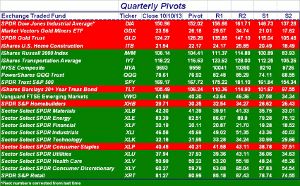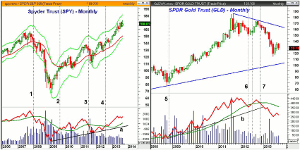It’s easy to get caught up in the drama and hype of financial news, so Moneyshow’s Tom Aspray urges discipline and details how a numbers-based strategy for the markets will serve you better in the long run.
The panic selling early in the week reflected the changing views of many investors and traders. While some were dumping stocks, others were turning bearish as financial giant Fidelity got lots of press over dumping its short-term T-bills. Some old pros recognized the opportunities as Pimco’s Bill Gross was apparently a willing buyer.
Those who changed their investment plans in frustration or fear over the looming financial crisis may already be regretting their action after the Dow’s 323-point gain. Most of the major averages were up well over 2%. Those who reacted to the “market noise” by going short early in the week had little chance to get out. For example, the Spyder Trust (SPY) Oct. 170 put dropped 47% in one day, as it opened 25% lower from the prior day’s close.
So what can one do to avoid getting burned during one of these financial crises? First of all, I would avoid watching any of the major financial networks as their anchors oscillate from the depths of despair to a rose-tinted view of the economy and markets. Basing your decisions on hard numbers instead of what may or may not happen should keep you from changing your mind at just the wrong time.
Though the current crisis may not be over yet, there are certain to be others in the years ahead so it is not too late to start following a numbers-based strategy. In my recent trading lesson, How To Invest in the 4th Quarter, I featured a quarterly OBV chart of the S&P 500 that has just given five signals since 1993.
Using the quarterly pivot analysis can also help you stay with the major trend as I discussed last summer. The 4th quarter pivot table has been updated through the close on October 10. Those highlighted in green are above the quarterly pivot while those below it are in red.
Staying long those markets that stay above their quarterly pivots on a weekly closing basis and avoiding those that don’t can help keep you with the major trend. It does not require daily or intra-day monitoring of the markets.
The Spyder Trust (SPY) closed the first week of 2013 well above its quarterly pivot at $142.64 and the market has not looked back. The 4th quarter pivot is at $167.72, and this week, the SPY traded as low as $164.53 but is now at $169.17, so it looks ready to close above the quarterly pivot again this week.
In contrast, the SPDR Dow Jones Industrials (DIA) closed the first week of the 4th quarter below its pivot and hit the quarterly S1 support at $146.97 this week. It is still likely to close the week below its pivot. The Powershares QQQ Trust (QQQ) is up 20.7% so far this year, which is about 2% better than the SPY. It has only had one weekly close below its quarterly pivot so far in 2013.
The SPDR Gold Trust (GLD) closed January 4 at $160.44, which was below the 1st quarter pivot at $165.21. It stayed below the quarterly pivot on a weekly closing basis until August 16 when GLD closed at $132.58 and was already down 19.8% for the year. Since August, it has had weekly closes both above and below its quarterly pivot but looks ready to close this week below the pivot.
In addition to the quarterly pivot point analysis, I think you will find the monthly OBV analysis quite useful in determining the major trend.
NEXT PAGE: Monthly OBV on 2 Key Markets
|pagebreak|Chart Analysis: The monthly chart of the Spyder Trust (SPY) goes back to 2006 and includes the monthly on-balance volume (OBV) with its 21-period WMA.
- The OBV moved above its WMA at the end of July 2006 when the SPY closed at $127.85.
- It stayed above its OBV until the end of January 2008, line 1, when it turned negative.
- The OBV was below its WMA for the next 20 months until September 2009, line 2.
- The OBV stayed positive until the end of July 2011 (line 3) as stocks plunged in reaction to the last debt ceiling crisis.
- It was not until the end of August 2012 that the OBV moved back above its WMA, line 4.
- This signal is still in effect as the OBV is well above its rising WMA.
- Up through October 10, the OBV was close to its recent high.
- The monthly OBV is well above the uptrend, line a, that goes back to the 2009 lows.
The SPDR Gold Trust (GLD) had a tremendous rally from the October 2008 low of $66.00 to the September 2011 high of $185.85.
- In November 2008, line 5, the monthly OBV moved above its WMA as GLD closed the month at $80.31.
- The monthly OBV stayed above its WMA until the end of May 2012, line 6, as GLD closed at $151.36.
- At the end of July 2012, the OBV moved back above its WMA with GLD closing at $156.49.
- By the end of November 2012, with GLD at $166.05, the OBV dropped below its WMA, line 7.
- Since then, GLD has dropped over 25%.
- Three months later, the uptrend in the OBV was also broken.
- The monthly OBV is currently still well below its declining WMA.
What it Means: The quarterly pivot data can give you a good reading on the major trend depending on whether the weekly closes are above or below the quarterly pivot. For long-term positions, it is a good idea to see two consecutive weekly closes above or below the pivot to signal a change.
The R and S quarterly pivot levels can also be used as another measure of support and resistance. For example, the Sector Select Health Care (XLV) had a high in September of $52.19, which was very close to the 3rd quarter R2 level of $52.46.
The monthly OBV can also give one early signs of a trend change. This analysis is still clearly positive for the Spyder Trust (SPY) and negative for the SPDR Gold Trust (GLD).
How to Profit: No new recommendation.
Editor’s Note: I will be on vacation for the next two weeks and the next Charts in Play will be published on October 28.













